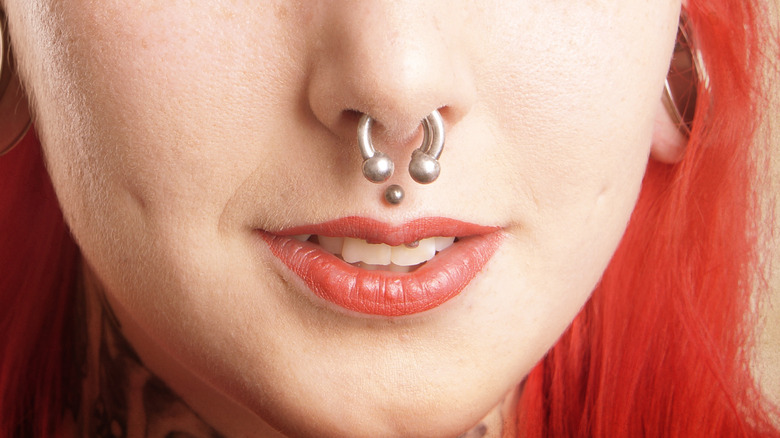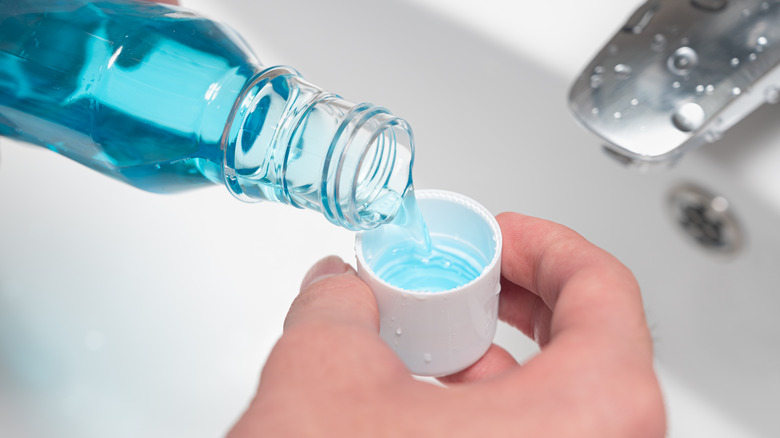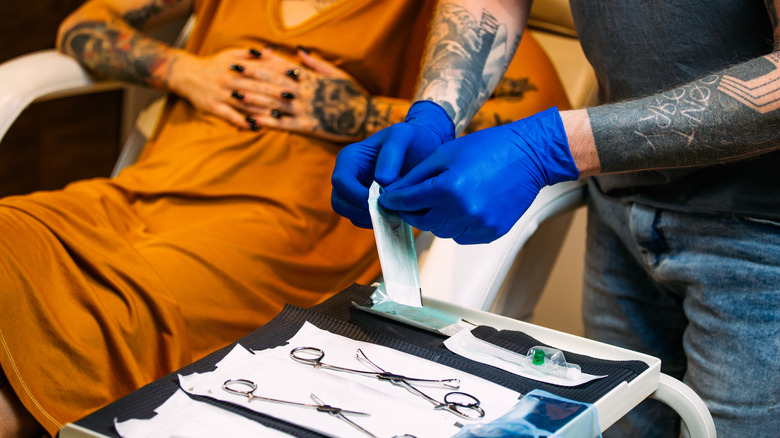What To Know Before Getting A Medusa Piercing
If you have found yourself charmed by the idea of a meaningful Medusa tattoo but prefer to get in on the hottest piercing trends instead, you should consider combining the two concepts. How can you accomplish this? Well, you can get what's known as a Medusa piercing.
An option that's certainly not as common as pierced ears or even a pierced nose, a Medusa piercing — named after the mythical snake-haired lady — is done on the Cupid's bow above your upper lip and below your nose. This area is also called the philtrum, which is why this particular piece of body art is also referred to as a philtrum piercing. You can opt for one of two kinds of Medusa piercings: a single piercing done vertically or a double piercing involving two holes stacked in line. This allows you to wear two different studs or a longer piece that requires two holes.
We can understand if you're already eager to run out and get a Medusa piercing for yourself. Of course, before you book an appointment, you should know a few other essential details, from the physical aspects to the financial requirements and what you might have to deal with if something (eek) goes wrong.
Does a Medusa piercing hurt?
Unless you're impervious to pain, all piercings will come with discomfort, if not downright stabbing, burning unpleasantness. However, you don't have to worry about passing out from the pain when it comes to a Medusa piercing. That's because it's not on the high end of the scale regarding how much piercings may or may not hurt.
To prepare you for exactly what you should expect during your appointment, you should know that the piercing needle will need to pass through and puncture the tissue and collagen in the philtrum area, according to Medical News Today. Because it's somewhat stretchy, the skin may be a little resistant, but a pro will know how to properly deal with what they're facing. You should also know that this area has several nerve endings — more than can be found in your ear lobe. That's why you will feel a sharp pain when the needle goes through. The good news is that it shouldn't last too long, and when the pain has passed, you'll be left with a super cool piercing that you'll (hopefully) adore.
How much does a Medusa piercing cost?
In the same way that a Medusa piercing isn't the most painful or painless option, it's also not the cheapest or most expensive. While other piercings can cost anywhere from $30 to $100, that price can be higher or lower depending on what kind of jewelry you choose to get with your piercing. The same goes for the Medusa variety, which can cost $40 to $80 for the piercing alone.
If you're unsure what kind of jewelry to use, you can consider the cost and ensure it aligns with your budget. At the same time, be sure not to choose the cheapest option simply because it's the most affordable. You want to ensure that whatever you pay for is of decent quality, such as an implant-grade material. You might also want to avoid hoops or intricately designed pieces at first. An affordable and reasonable labret stud is likely your best option because it has a flat back attached to a longer bar. Not only will it look fabulous, but it will also help you get used to the feeling of the piercing as it heals and won't break the bank.
The best jewelry to wear with a Medusa piercing
Once your Medusa piercing has healed, you can be more creative regarding the jewelry you want to wear and show off in this spot. However, when you first have it done, you should likely stick with one of two materials — or perhaps one after the other. This is because certain higher-quality materials don't involve problematic properties and will help keep your piercing safe from infections, allergic reactions, and other unfortunate issues you want to avoid.
The first is implant-grade titanium. Your professional piercer might also know it as ASTM F-136, ISO 5832-3, and ASTM F-67, according to Healthline. Both lightweight and strong, which are undoubtedly ideal perks, it doesn't contain any nickel, which can cause allergic reactions. The second option is none other than gold. After your piercing has healed, DentalCare.com says that you can use a gold piercing as long as it's 14K gold or above, but no less. Indeed, taking the time and care to choose the right type of jewelry for your piercing will pay off both in the short and long run.
How long does a Medusa piercing take to heal?
The amount of time it will take your Medusa piercing to heal depends on multiple factors. That includes how your body reacts to piercings and how well you care for it during the first few days and weeks after getting it done. You should be aware that piercings in the mouth or around the lips can take longer to heal than other spots, according to Medical News Today. Medusa piercings, which extend into the interior of your mouth through the philtrum area, generally take around eight to 12 weeks to heal fully, per Healthline.
During that time, MNT notes that you'll need to expect some bleeding, swelling, and bruising. This should last for around one to two weeks. The area around your piercing may be sore and tender during this initial period. If the pain is too much for you to handle, you can use ice to numb your skin and tissue. You can also take an over-the-counter painkiller to calm things down until your piercing starts to heal. Following the proper aftercare practices to make that process easier and faster would be best.
What does aftercare for a Medusa piercing involve?
After getting a Medusa piercing, it's essential to take care of it so that it heals properly and you don't end up with any unfortunate side effects. This means you'll want to wash your hands before touching your piercing, clean the spot regularly, and ensure your teeth and gums aren't gunky. You might also want to grab a new toothbrush and elevate your head while sleeping. On top of that, DaVo, a piercer and the owner of Axiom Body Piercing as well as the head creator of Body Piercing & Tattooing on YouTube told Healthline, "I suggest eating two to three cartons of yogurt and rinsing a couple of times a day with an alcohol-free mouthwash and warm water and sea salt."
As the swelling subsides, your jewelry may start to feel odd. At this point, you can have your piercer swap it. DaVo says, "If the longer jewelry is creating an issue, it should be downsized to a shorter labret stud. I suggest that you have your piercer change it for you. Either way, once the piercing is healed, shorter jewelry needs to be put in to reduce the risks of damage to gums, teeth, and bones." At the same time, you'll want to stay away from alcohol, smoking, and vaping while your piercing is healing. If that's hard to do for the full eight to 12 weeks, you can refrain for at least the first three to five days.
How to change a Medusa piercing
If you reach the six-month mark and feel like your Medusa piercing has progressed nicely, it's likely time to change the jewelry to something more suitable for the healed hole. This should be done to remove a larger piercing and put in a smaller one that will be more comfortable for you at this stage. The idea of doing this yourself may be a little daunting, so you can make an appointment with your piercer, who can make the change for you. If you choose this option, you can rest assured that it will be done correctly.
On the other hand, you might want to try to change your Medusa piercing on your own. "People always ask advice on changing their jewelry at home. The truth is that it's tricky working on yourself," Johnny Pearce, a piercer at Nine Moons Piercing and a Member of The Association of Professional Piercers (APP), told Byrdie. " You'll want to ensure your hands are clean before you fiddle with the jewelry. Beyond that, you can slip on a pair of latex gloves. "Gloves make it easier to grip your jewelry and also help prevent the transfer of bacteria from your hands. Sometimes keeping a piece of gauze on hand can help dry saliva from the area, making removal slightly easier," he added.
How to take out a Medusa piercing permanently
Although you might adore your Medusa piercing, you might also change your mind about it once you've had it done. In that case, you can always take it out permanently, according to Medical News Today. If you want to do this right after getting the piercing, you should head back to see the professional who put it in. They will be able to remove your piercing safely. If the hole hasn't fully closed up, healing shouldn't take too long.
If you've had your Medusa piercing for quite a while — we're talking about months or years — then you can still take it out if you no longer want it. Granted, you should know that a scar will be left behind, according to Lauren on the Treacle Tatts YouTube channel. She ended up with a slight indent where her piercing used to be after taking it out because it was causing her discomfort (and a lot of pain when she accidentally bit down on it). When she gave the camera a close-up view of her scar, it appeared to be a tiny dot just above her top lip in the middle of her Cupid's bow. It's likely something that could be covered with a bit of makeup, though you might decide to forgo this possibility by not getting the piercing in the first place.
Potential drawbacks of a Medusa piercing
Various issues can pop up after you have a Medusa piercing done. While some are more common than others, you should know what you might end up dealing with. For instance, bumps can occur around the area where the piercing was done. This happens when the body assumes the pierced spot is damaged and triggers a response trying to heal it, according to Medical News Today. This is also why the body should calm down after a while, and the bumps will likely go away without you having to act. However, you can attempt to prevent them from happening in the first place by keeping the area as clean as possible.
On top of that, Medusa piercings that aren't properly cared for can become infected or, perhaps even worse, the body can reject the piercing. For minor infections, you can wash the area thoroughly and then dissolve salt in water, which can be gently applied to the infected area with a cotton ball, per the Mayo Clinic. On the other hand, if the infection is painful, swollen, itchy, red, or you have any other reason to worry, it's time to see a doctor as soon as possible. The same goes for a piercing that you suspect is being rejected. Watch out for redness, flakiness, or an increase in the hole size.








